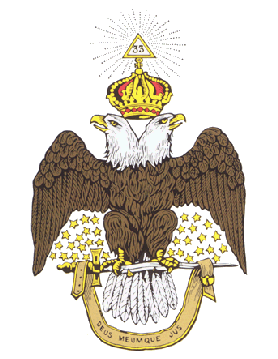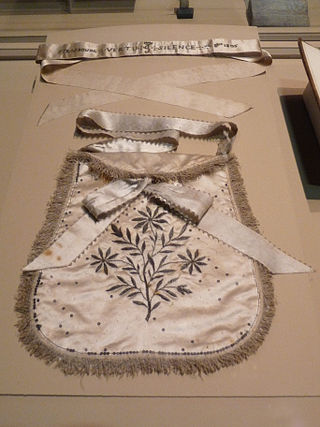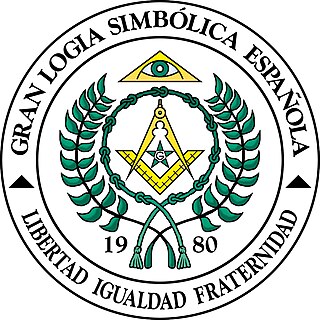
The Ancient and Accepted Scottish Rite of Freemasonry is a Rite within the broader context of Freemasonry. It is the most widely practiced Rite in the world. In some parts of the world, and in the Droit Humain, it is a concordant body and oversees all degrees from the 1st to 33rd degrees, while in other areas, a Supreme Council oversees the 4th to 33rd degrees.
In Freemasonry, regularity is one of the factors by which individual Grand Lodges judge whether to recognise one another for the purposes of allowing formal interaction at the Grand Lodge level and visitation by members of other jurisdictions. Each individual Grand Lodge determines which other Grand Lodges it considers Regular.
Co-Freemasonry is a form of Freemasonry which admits both men and women. It began in France in the 1890s with the forming of Le Droit Humain, and is now an international movement represented by several Co-Freemasonic administrations throughout the world. Most male-only Masonic Lodges do not recognise Co-Freemasonry, holding it to be irregular.

The International Order of Freemasonry Le Droit Humain is a global Masonic Order, membership of which is available to men and women on equal terms, regardless of nationality, religion or ethnicity.
Freemasonry in Sweden was introduced by the Swedish Order of Freemasons, founded in 1735 as the oldest still active Swedish fraternal order, working the Swedish Rite of Freemasonry. It is under royal patronage of the King of Sweden and closely associated with the Lutheran Church of Sweden. It is a jurisdiction that admits Christian men only, and is recognised by the United Grand Lodge of England as a Regular Masonic jurisdiction, being the only Regular Grand Lodge that admits a 34th informal Masonic Degree. Its total membership is about 16,500.
The Grande Loge Nationale Française (GLNF) is a French Masonic Grand Lodge. It was founded in 1913, by two lodges, "Le Centre des Amis" Lodge splitting from Grand Orient de France and "L'Anglaise" lodge, an independent lodge based in Bordeaux. GLNF is based on monotheism and the 1929 precepts of regularity issued by the United Grand Lodge of England.
This is a general survey on the historical and modern presence of Freemasonry in countries located in Asia.
The Grand Orient of Portugal is a symbolic Masonic Obedience founded in 1802, thus being the oldest Portuguese Masonic Obedience. Its first Grand Master was Sebastião José de São Paio de Melo e Castro Lusignan, grandson of the first Marquis of Pombal, and his symbolic name was Egas Moniz.

Freemasonry has had a complex relationship with women for centuries. A few women were involved in Freemasonry before the 18th century, despite de jure prohibitions in the Premier Grand Lodge of England.
The International Secretariat of the Masonic Adogmatic Powers (ISMAP) was an international organization of Masonic jurisdictions of masonic lodges. The jurisdictions involved are considered irregular by the United Grand Lodge of England (UGLE) and most other Anglo-Saxon Grand Lodges, because they accept women, or do not require Masons to have a belief in a Supreme Being. Its members merged back into CLIPSAS in the early 2010s.
Freemasonry in Denmark was first established in 1743 and is today represented by a number of Grand Lodges. The oldest and biggest Masonic Grand Lodge in Denmark is the Danish Order of Freemasons, in English also known as the Grand Lodge of Denmark.
Continental Freemasonry, otherwise known as Liberal Freemasonry, Latin Freemasonry, and Adogmatic Freemasonry, includes the Masonic lodges, primarily on the European continent, that recognize the Grand Orient de France (GOdF) or belong to CLIPSAS, SIMPA, TRACIA, CIMAS, COMAM, CATENA, GLUA, or any of various other international organizations of Liberal, i.e., Continental Freemasonry. The larger number of Freemasons, most of whom live in the United States–where Regular Freemasonry holds a virtual monopoly–belong to Masonic lodges that recognize the United Grand Lodge of England and do not recognize Continental Freemasons, regarding them as "irregular".
With 84 lodges and 3’350 members, the Grand Lodge Alpina of Switzerland (GLAS) is a Swiss Masonic obedience founded in 1844.
Freemasonry in Belgium comprises several Masonic obediences, a federation and a confederation. These include Grand Orient of Belgium, the Grand Lodge of Belgium, the Regular Grand Lodge of Belgium, the Women's Grand Lodge of Belgium, the Belgian Federation of Le Droit Humain and Lithos Confederation of Lodges.
Continental Freemasonry in North America is relatively rare, but there are a few continental-style organizations active.
The history of Freemasonry in Belgium reflects the many influences on what is now Belgium from the neighbouring states.
The Liaison and Information Centre of Signatory Masonic Powers of the Strasbourg Appeal or CLIPSAS is an international group of Masonic Grand Orients and Grand Lodges that adhere to Continental Freemasonry and signed the Strasbourg Appeal. Members include the Grand Orient de France, the Grand Orient of Belgium and the Grand Lodge of Italy, of which the first two left the group between 2000 and 2010.
Freemasonry in Spain is first recorded in 1728, in an English lodge. As various papal bulls condemned Freemasonry the Spanish Inquisition did their best to close lodges and demonise Freemasons, therefore the success of Freemasonry from year to year depended on the sympathy or antipathy of the ruling regime. Nevertheless, lodges and even Grand Lodges were formed, and even thrived during more liberal periods. When Francisco Franco consolidated power in 1939, all Freemasonry was banned. In 1979, four years after Franco's death, bans on Freemasonry were declared unconstitutional, and several Grand Lodges and Orients now flourish in Spain.
Freemasonry in Italy dates to the first half of the eighteenth century. Its success largely depended on the lack of enthusiasm with which Papal bans on the order were enforced in the various states. After the end of the Napoleonic regime, Freemasonry was suppressed in most of the peninsula. The start of the unification process in 1859 saw a revival in Freemasonry. Giuseppe Garibaldi, a leader of Italian unification, was an active Mason and a keen supporter of the craft. In the 1920s, Freemasonry was again suppressed under Italian fascism but revived again after the fall of Benito Mussolini. Into the 21st century, Italy contains a wide variety of Masonic observances, regular, liberal, male, female and mixed.

The Symbolic Grand Lodge of Spain is one of the main grand obediences in Spain. It is one of group of obediences included in CLIPSAS, and can be defined as a mixed or egalitarian, liberal and non-dogmatic Grand Lodge.






